
Ginkgo biloba, maidenhair tree: planting, care and uses
Contents
Ginkgo biloba in a nutshell
- Ginkgo biloba is a majestic tree renowned for its longevity and resilience,
- Often described as a living fossil, it was around even before dinosaurs and is practically resistant to everything: disease, pollution…
- In the garden, it is valued for its striking, architectural foliage that turns golden yellow in autumn
- The typical species can be rather large, but many dwarf or fastigiate cultivars exist.
- With slow growth in its early years, it’s a tree to plant as a specimen in the garden, but it also grows well in a pot.
Word from our expert
Although botanically close to conifers, Ginkgo biloba, or the “tree of forty coins”, is a deciduous tree. It is the last surviving representative of its family, the Ginkgoaceae.
Close to conifers in its flowers, resembling a “single” deciduous tree in its leaves and with a mode of reproduction akin to that of ferns, Ginkgo biloba is truly a botanical curiosity.
It is planted in the garden as a specimen for its striking foliage, which turns a beautiful golden-yellow in autumn. But it is also widely used in bonsai or in collections of mini-conifers (reminder: it is not a conifer!) for dwarf cultivars, true botanical jewels.
Ginkgo biloba is a tree of remarkable resilience. It has no known diseases or predators and it resists pollution admirably. It was, in fact, the first tree to regrow after the nuclear explosion in Hiroshima!
Description and botany
Botanical data
- Latin name Ginkgo biloba
- Family Ginkgoaceae
- Common name Ginkgo biloba, Maidenhair tree, Silver apricot
- Flowering April to May
- Height from 1 m to 40 m (depending on cultivars)
- Exposure sun
- Soil type ordinary even calcareous, fresh and free-draining
- Hardiness Down to -30°
A true living fossil, Ginkgo biloba, also called “maidenhair tree” or “silver apricot“, appeared on Earth during the Jurassic, around 190 million years ago. It is now the last surviving representative of its family, the Ginkgoaceae, the oldest botanical family still present on Earth, which appeared nearly 270 million years ago.
Native to south-east China, in the Tianmushan mountains, there are now virtually no wild specimens left. Its conservation status is listed as “endangered” and the Tianmushan nature reserve was created to continue protecting the last wild specimens and this very particular biotope.
It has been cultivated in China for millennia and in Japan and Korea since the 12th century. The first Ginkgo biloba only arrived in Europe in 1730, in Utrecht. In France, it was brought back by Auguste Broussonier in 1778 and planted at the Jardin des Plantes in Montpellier. A cutting from the latter was taken and planted in 1795 at the Jardin des Plantes in Paris. Both are still alive and in good health today.
Slow-growing in its early years, Ginkgo biloba can become very large, more than forty metres, and live for a very long time. Some planted in Asia are millennia old. According to Francis Hallé, it could even be immortal since no predator, disease or parasite is known. Only climatic hazards or the axe of the woodcutter can finish it off. Even a nuclear explosion was not enough… Indeed, Ginkgo biloba was the first tree to regrow in Hiroshima after the war.
→ To learn more about the secret of its longevity, we recommend reading this article: “No planned obsolescence for Ginkgo biloba!“
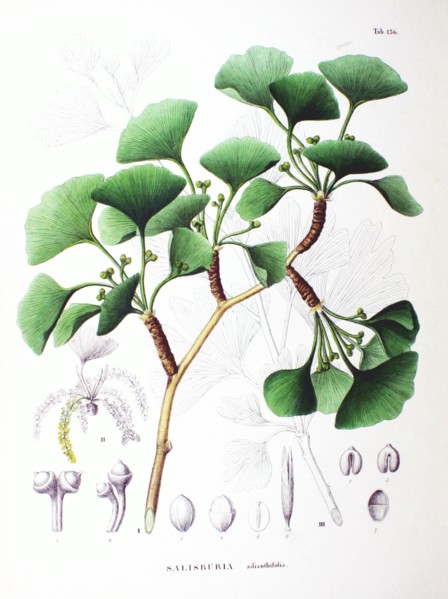
Ginkgo biloba – lithograph by Philipp Franz von Siebold and Joseph Gerhard Zuccarini
Its deciduous foliage is palmate, bilobed (hence the species name “biloba“) and petiolate, the leaves being grouped in 3s or 4s on short shoots. Leaves are more notched on female trees (see below). Initially light green, the foliage turns a remarkable golden-yellow in October. Its brown-grey bark is smooth at first then, with age, becomes fissured and cracked. On the trunks of old specimens tchitchis form, growths resembling breasts.
It is a dioecious plant, meaning there are male and female trees. Male trees produce small aments that release pollen, while female trees bear naked flowers, without floral parts. These transform into ovules which, once on the ground and fertilised by pollen, emit a particularly unpleasant rancid butter smell (butyric acid). Prefer male trees for planting. In fact, all the selected cultivars are male, to avoid this slight nuisance. Do not confuse the ovules, those small yellow-brown fleshy balls, with fruits or seeds. Indeed, ginkgo are classed among the Prespermaphyta; they therefore do not produce fruits or seeds, which means the ovule, once fertilised, must germinate as quickly as possible, often at the base of the tree. The young plant thus formed will not be sexually mature until at least 15 years old.
Ginkgo biloba prefers to grow in full sun. It is very hardy, very resilient and very tolerant of soil conditions. An ordinary, free-draining soil, even slightly calcareous, suits it, but it does not like waterlogged conditions. It tolerates drought, wind and air pollution.
In youth, Ginkgo resembles a sort of large skeletal broom before, over the years, adopting a broad upright habit with very short shoots. Male trees have a more erect habit while female trees adopt a more spreading habit and are a little less vigorous. There are columnar varieties (such as ‘Blagon’ for example) or weeping ones (the ‘Pendula’ variety).

Foliage of Ginkgo biloba through the seasons
Read also
Major diseases and pests of conifersOur favourite varieties
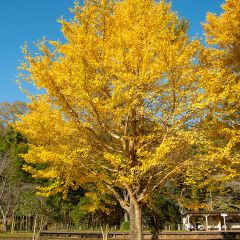
Ginkgo biloba - Maidenhair Tree
- Height at maturity 15 m
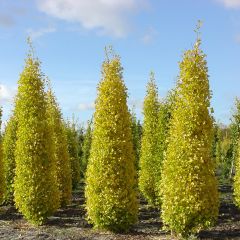
Ginkgo biloba fastigiata Blagon
- Height at maturity 10 m
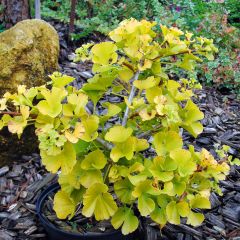
Ginkgo biloba Mariken
- Height at maturity 2,50 m
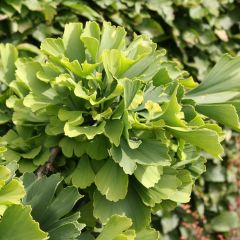
Ginkgo biloba Troll
- Height at maturity 1,10 m
Discover other Ginkgo
View all →
Available in 2 sizes
Available in 2 sizes
Available in 1 sizes
Available in 2 sizes
Available in 2 sizes
Available in 1 sizes
Available in 1 sizes
Available in 1 sizes
Available in 1 sizes
Available in 1 sizes
Planting Ginkgo biloba
Exposure and soil
Ginkgo biloba is very easy to grow and appreciates sunny situations. As for soil, it is not demanding: ordinary soil, even poor, stony or chalky, suits it. The only thing it dislikes in soil is stagnant moisture.
Planting period
Wait until spring, after frosts (March–April), to plant your Ginkgo biloba as a rootball or in a container. You can also, as with other conifers and evergreens, plant it in early autumn (October) to ensure good rooting before winter. Prefer young trees for reliable establishment.
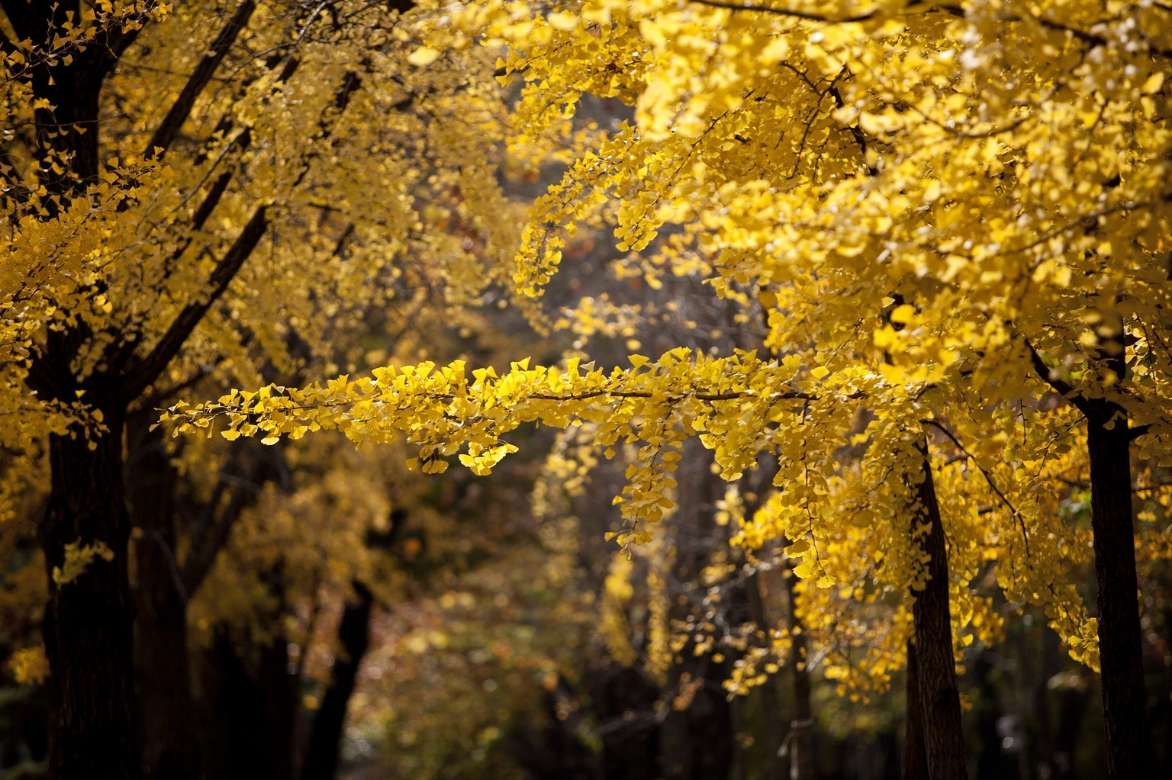
How to plant a Ginkgo?
In open ground
- Immerse container in water for a few hours to rehydrate the rootball
- Remove tree from pot but do not break up the rootball
- Dig a hole twice the width and twice the depth of the rootball
- Ginkgo has a tap root initially that will anchor the tree in the soil before growth of adventive roots. Consequently, it is probably best to loosen soil deeply at bottom of hole.
- Once soil is loosened, add a few handfuls of well-rotted compost; you can add a little sand if soil is compact
- Place rootball at bottom of hole and backfill with excavated soil
- Firm surface and apply 10 litres of water to avoid possible air pockets
- Apply a mulch (dead leaves, herbs, …) to help tree weather a spell of summer drought and/or a period of frost in winter, at least during those first years
In pot
- Immerse container in water for a few hours to rehydrate the rootball
- Remove tree from pot but do not break up the rootball
- Choose a container with a volume twice that of the rootball. Be careful: there must be one or more drainage holes!
- Use a mix of 1/3 potting compost – 1/3 ordinary soil – 1/3 sand to provide a rich yet light, well‑drained soil
- Place a draining layer of small gravel at bottom of pot, then a layer of your soil mix about one‑third of pot height
- Place rootball in pot and backfill with your soil mix
- Firm surface and water well to avoid possible air pockets
- You can place a “mulch” around the trunk with pebbles or bark. please note : for a bonsai, technique remains identical but you must prune about half the roots with pruning shears sterilised with alcohol. Cut must be fairly deep, at least 15–20 centimetres deep. In winter, shelter tree in a place protected from frost. Soil mix can be 70% Akadama and 30% potting compost for better drainage.
Multiplication
By sowing fertilised ovules
You can simply collect gently young plants that have germinated beneath an adult female tree or gather a few ovules fallen to the ground. Dip collected ovules in water at 70°C for five minutes so that the seed coat splits. If not in a hurry, you can place ovules to stratify in moist sand over winter (less effective in my experience). Sow immediately under cover in potting compost for bonsai or a light, free-draining soil (half potting compost – half sand). Keep your young plant for one year before transplanting to open ground.

Ginkgo biloba ovules
By propagation by cuttings
Take short semi-ripe lateral shoots, that is, a shoot of the year that has begun to lignify at the base but remained tender at the tip. Remove leaves except two or three at the tip. Most leaves of a shoot or branch to be propagated are always removed; this avoids excessive evapotranspiration while keeping some for photosynthesis. Coat the tip with plant hormone or place in a little water in which you have kept some willow branches for one or two nights (a free natural plant hormone!) to facilitate rooting. Insert the shoot into a mix of potting compost and sand. Wait a few months after successful take before placing the tree in open ground.
By air layering
Strip the bark from a branch you wish to air-layer. Surround this wound with moist sphagnum and wrap the lot in a plastic bag with holes, secured with raffia. Mist daily to prevent drying out. As soon as roots appear in this ball of sphagnum, you can pot up into a light substrate, half potting compost and half sand. Wait a few months before planting in open ground. This method is ideal for producing bonsai with twisted or slightly contorted forms.
By lateral grafting
On a young own-root Ginkgo biloba (that is, species type), you can graft into the lower part of the trunk so that later soil will hide the graft union. Split the rootstock, the own-root Ginkgo, vertically for two centimetres with a grafting knife. The idea is to make an incision a few millimetres deep and open this wound by prising apart the bark. Place into this split a branch cut on a slant from the variety you wish to reproduce. Wrap with raffia and tie firmly (personally I use large clothespins if the rootstock is not too wide, which allows me to remove them and check there is no rot, the main cause of graft failure). This method is perfect for multiplying a specific variety and therefore best reserved for professionals or experienced amateurs.
Ginkgo biloba: maintenance, pruning and care
Care
During its first years, think about keeping some moisture at the base of the tree. But not too much! In short, a simple mulch of herbs or dead leaves and occasional watering during particularly dry summers, and your Ginkgo biloba will thrive.
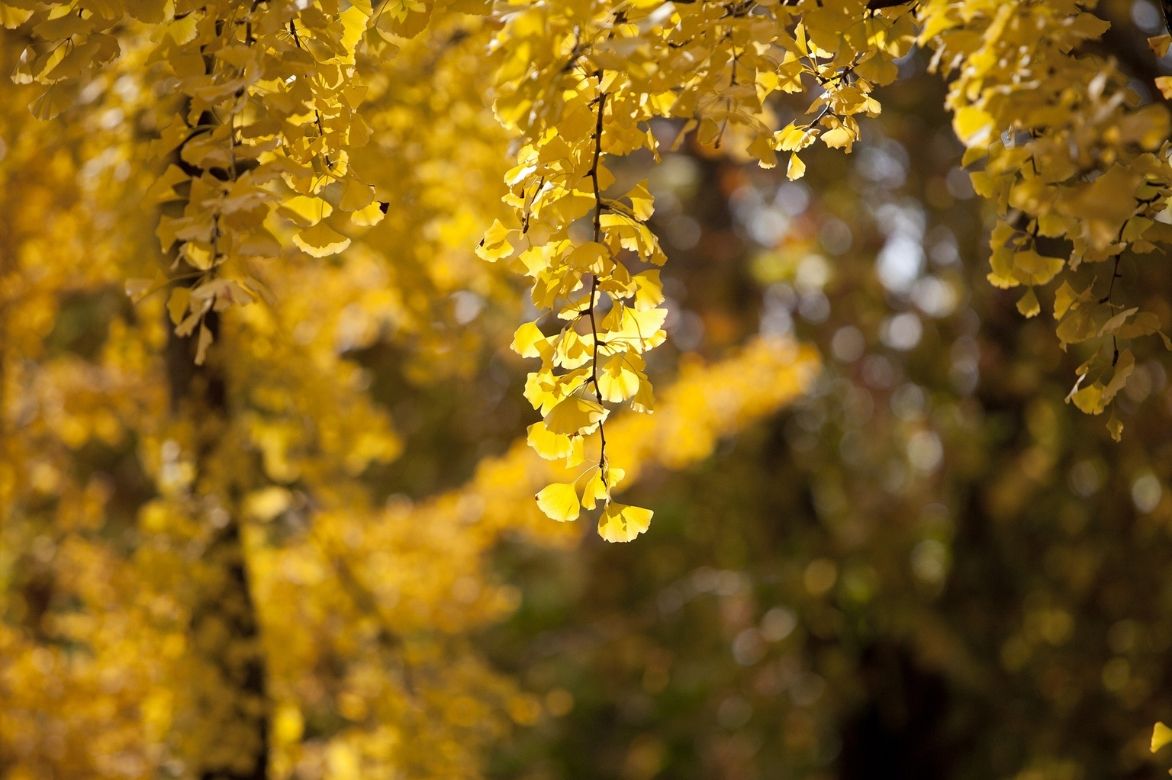
Pruning
Although a favourite subject for bonsai and extremely resilient, even to the harshest treatment, Ginkgo biloba does not particularly appreciate pruning. If you can avoid it, do so! This will spare your tree unnecessary wounds and an unbalanced structure.
Pests and diseases
To date, no disease, pest or parasitic organism is known to affect Ginkgo biloba.
Association and use
Alone, certainly, but set in a beautiful setting…
Ginkgo biloba is a marvel simply placed on its own (like a grown-up!) in the centre of a short grass meadow. But… Don’t forget to give it a striking contrast in the background, especially in autumn. In that case, pull from your (straw) hat conifers and evergreens with dark or bluish foliage. For example, this striking Pinus nigra ‘Molette’ or the ever-charming Picea pungens ‘Jeddeloh’, whose blue thorns will contrast with the golden-yellow autumn foliage of the Ginkgo, and why not a handsome Magnolia grandiflora ‘Alta’ whose dark green evergreen foliage will reinforce the tender green of our “tree of forty coins”. Don’t place these too close together, after all, they have an ocean of distance in their natural medium… To dress the base of your Ginkgo biloba, a tapetum of Pachysandra terminalis will be a good idea if your tree provides it with enough shade.

A planting idea: Ginkgo biloba, Picea pungens ‘Jeddeloh’, Magnolia grandiflora ‘Alta’ and Pachysandra terminalis
In a zen corner of the garden
In the quietest corner of your garden, the one where even that annoying neighbour dares not interrupt your meditation for fear of incurring your wrath: install Ginkgo biloba ‘Blagon’ alongside an Acer shirasawanum ‘Jordan’ with autumn colours as vivid as its companion, a charming Prunus serrulata ‘Amanogawa’ with a habit as fastigiate as its golden‑coin friend, and a tapetum of Hakonechloa macra. Your garden has suddenly travelled about 10,000 km to find itself in the Land of the Rising Sun. Moshi‑moshi!

An example of a Japanese‑style planting: Ginkgo biloba ‘Blagon’, Acer shirasawanum ‘Jordan’, Prunus serrulata ‘Amanogawa’ and Hakonechloa macra
For a terrace with a chic, contemporary atmosphere
Ginkgo biloba ‘Mariken’ will keep good company with other Asian companions. The flowering of Camellia botanyuki will brighten your terrace in winter while Ginkgo is absent. Add a strong, graphic and elegant foliage presence in the form of a Fargesia murielae (don’t forget to water it!). We still lack seasonal flowers… So add two evergreens: the lovely Escallonia ‘Pink Elle’ with spectacular summer flowering and, for its scented presence, a Choisya dwarf ‘White Dazzler’.
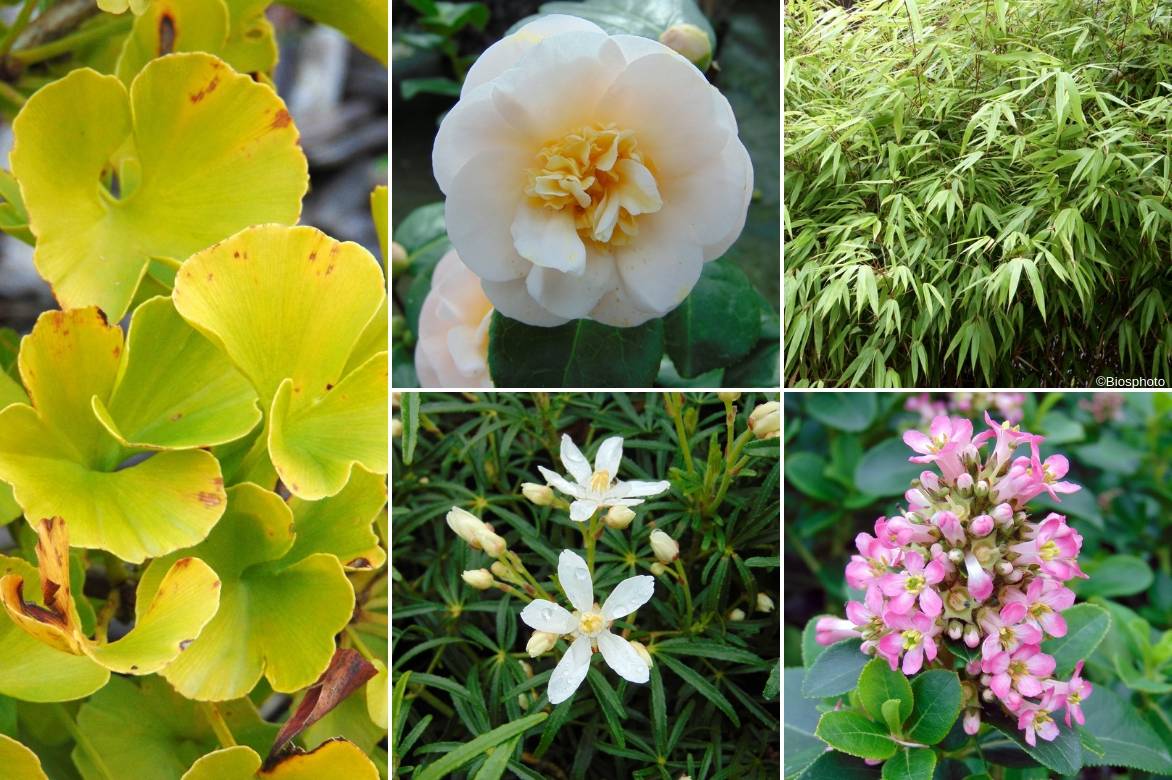
An example of a terrace planting: Ginkgo biloba ‘Mariken’, Camellia ‘Botanyuki’, Fargesia murielae ‘Panda’, Choisya ternata ‘White Dazzle’ and Escallonia laevis ‘Pink Elle’
In a rockery, lost among a collection of miniature conifers
The adorable Ginkgo biloba ‘Troll’ (what a name!) will be so original amid all those dwarf conifers and evergreens: a Chamaecyparis obtusa ‘nana’, a Cephalotaxus harringtonia ‘Korean Gold’, an Abies koreana ‘Kohout’s Icebreaker’, a Pinus densiflora ‘Alice Verkade’ and other Cryptomeria japonica… Who said conifers are cumbersome?! A tapetum of Erica carnea will act as a most attractive groundcover.

A rockery planting idea: Ginkgo biloba ‘Troll’, Cryptomeria japonica ‘Vilmoriniana’, Chamaecyparis obtusa ‘Nana Gracilis’, Abies koreana ‘Kohouts Icebreaker’ and Pinus densiflora ‘Alice Verkade’
Pointless anecdotes
- Pseudo-seeds are eaten in Asia roasted like pistachios once freed from the fleshy part; raw they are toxic.
- Pale-yellow Ginkgo wood is used in cabinetmaking and sculpture
- Slipping a few Ginkgo leaves into books would keep insects away
- Plant is also cultivated for medicinal purposes. Its medicinal properties (venous disorders, cardiac regulator, …) have been known for millennia, although recent studies report a non-significant effect. Research is currently under way into combating Alzheimer’s disease and Parkinson’s disease, without success so far.
- Surprisingly and exceptionally monoecious Ginkgo (male and female flowers on same tree) can occur in the wild, with no plausible explanation for this phenomenon.
- Its nickname “d’arbre aux quarante écus” would come from the fact that French botanist Monsieur de Pétigny allegedly bought from another botanist, an Englishman, five Ginkgo biloba for the staggering sum of 40 écus per tree. (which is probably much more expensive than in our nursery!)
- It is also called “arbre au mille écus“, probably in reference to the golden colour the Ginkgo dons in autumn.
- A symbiotic micro-alga of genus Coccomyxa lives in sym symbiosis within cells of Ginkgo Biloba. This type of endosymbiosis is unique on Earth.
- Ginkgo leaf is symbol of Tokyo while tree itself is symbol of the city of… Weimar in Germany.
- Les tchitchis, those nipple-shaped outgrowths on ageing bark, were good-luck charms for wet-nurses and young mothers.
Useful resources
Discover our selection of Ginkgo biloba.
Also discover 7 trees with unusual foliage
Our advice sheet: Choosing a Ginkgo biloba, our buying guide.
Frequently asked questions
-
I have a small garden. Can I still plant a Ginkgo biloba?
There are now many dwarf or fastigiate varieties. A fastigiate Ginkgo will shoot upwards but will not require much width. It can therefore be inserted easily into a modestly sized garden. Better still, dwarf varieties allow a Ginkgo to be grown even if you don't have a garden, for example in a pot on a terrace.
-
My Ginkgo doesn't seem to be producing shoots. What's wrong with it?
If you were careful when planting (see above) and your tree is planted in full sun, nothing will prevent it from producing shoots. But bear in mind that Ginkgo, especially during its first ten years, produces shoots very slowly. You just need to be a little patient.
-
When can I prune my Ginkgo?
Normally, Ginkgo biloba is not pruned. If, unfortunately, and for various reasons, you absolutely must intervene, wait until the end of winter (early March) to cut certain branches and remove dead wood. P.S.: dead wood is often caused by excessive pruning in Ginkgo. Bear in mind to preserve its silhouette when removing branches. Otherwise, leave it alone; it will be better for it.
-
A very unpleasant smell is wafting around my ginkgo. What’s happening?
You planted a female. Indeed, Gingko biloba is dioecious, meaning there are male and female trees, and only female trees produce ovules — small fruit-like structures which, once fertilised by pollen from a male and fallen to the soil, produce butyric acid that gives the unpleasant odour of rancid butter. When you see these ovules falling to the soil in September, pick them up quickly and store them in a corner of the garden well away from everything. Otherwise, next time make sure to plant only a male. Most varieties and cultivars are male-only to avoid this nuisance.
-
How to tell male from female Ginkgo when buying?
Before sexual ripeness, which occurs after at least fifteen years and sometimes longer, identification is very complicated. Their habit is slightly different, too slightly in fact to recognise them with certainty, and leaves are a little more notched on female Ginkgo. Male trees put out leaves about two weeks before female trees in spring and lose them about two weeks earlier in autumn. But you need male and female trees nearby to compare. Simplest option is to choose a selected variety. Selected varieties are always male to avoid unpleasant butyric odour released by ovules that fall to soil.
- Subscribe!
- Contents
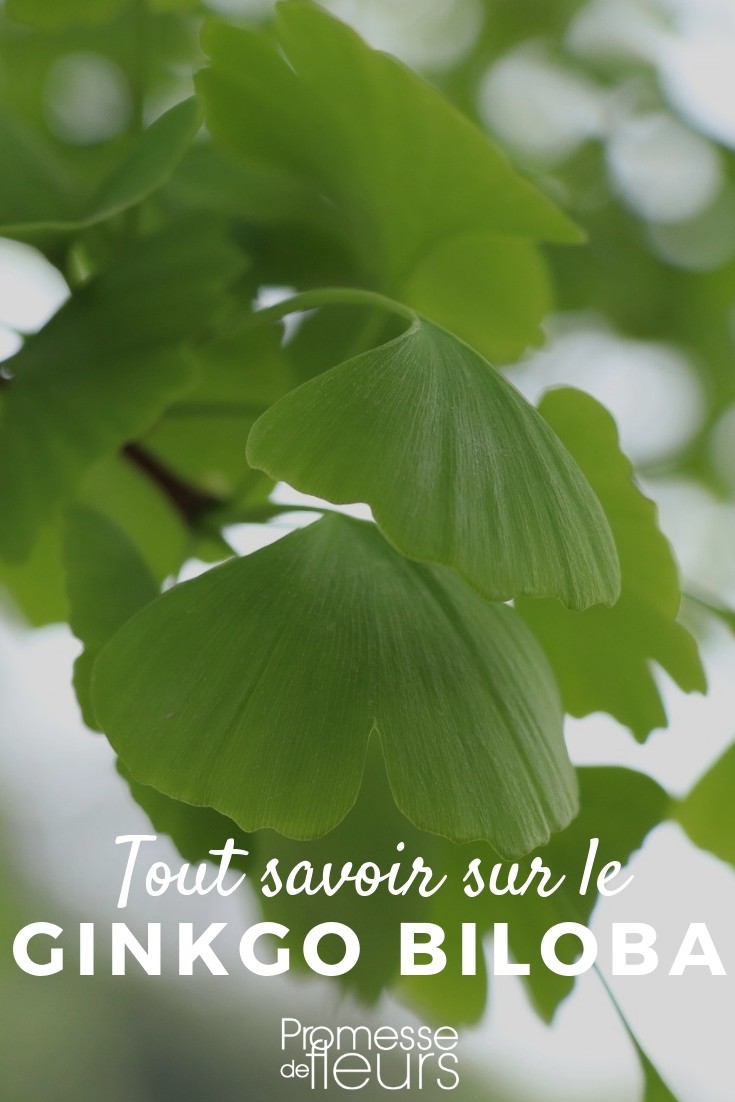
































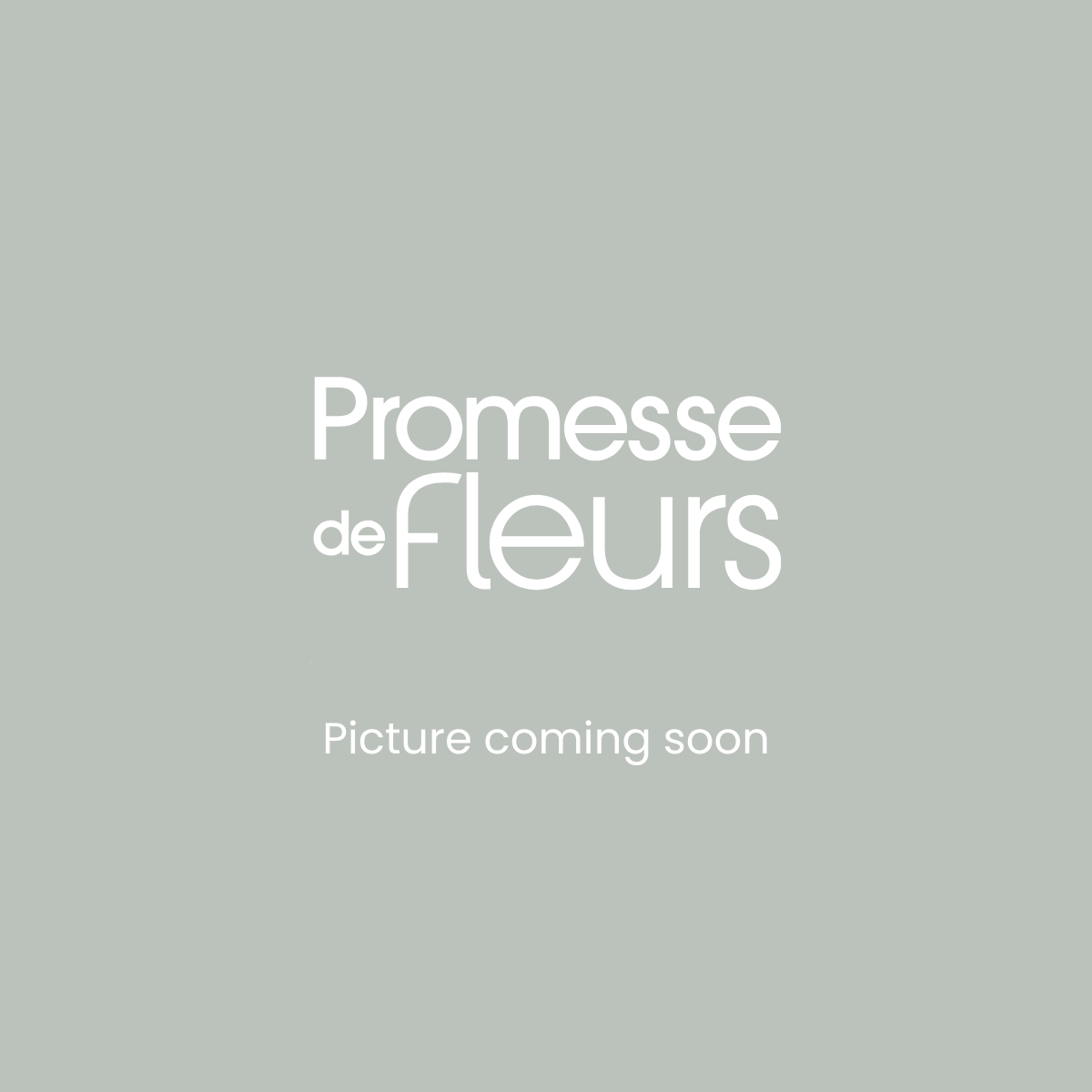


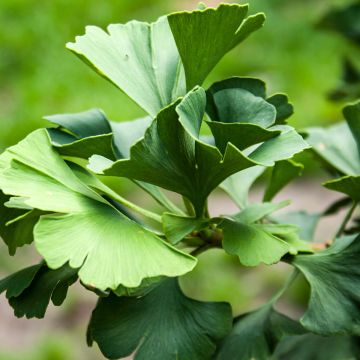
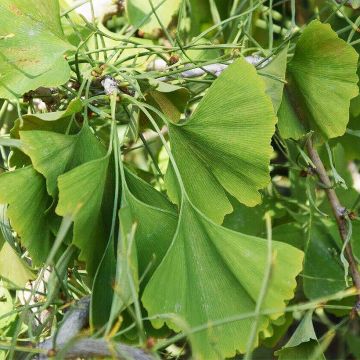
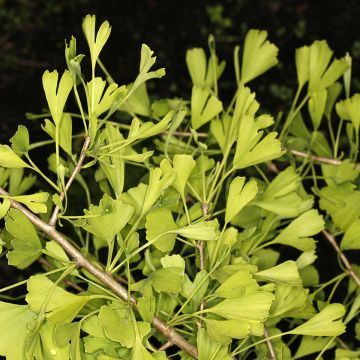


Comments